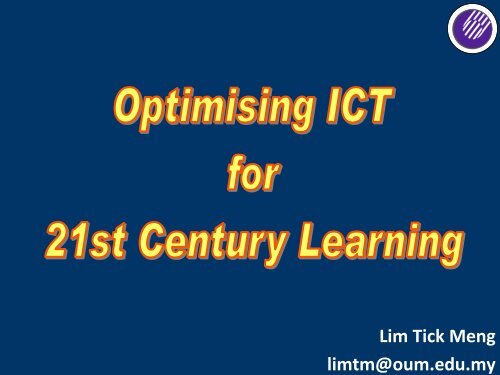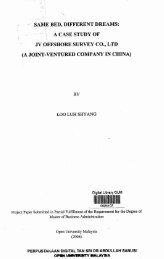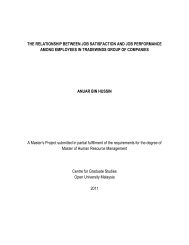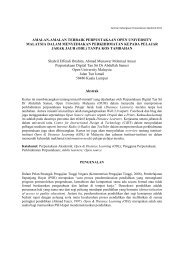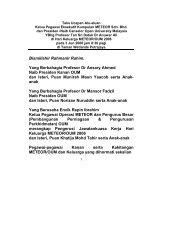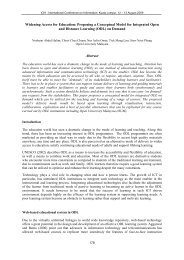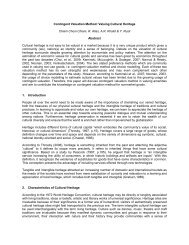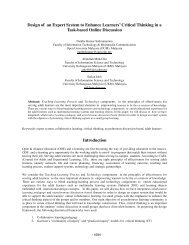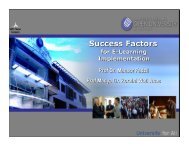Lim Tick Meng limtm@oum.edu.my - OUM i-Repository
Lim Tick Meng limtm@oum.edu.my - OUM i-Repository
Lim Tick Meng limtm@oum.edu.my - OUM i-Repository
You also want an ePaper? Increase the reach of your titles
YUMPU automatically turns print PDFs into web optimized ePapers that Google loves.
<strong>Lim</strong> <strong>Tick</strong> <strong>Meng</strong><br />
<strong>limtm@oum</strong>.<strong>edu</strong>.<strong>my</strong>
Part 1
of what learners learn today<br />
will become obsolete soon
How many new books do you<br />
think are published every day?<br />
Total amount of digital knowledge will be<br />
doubled<br />
every 11 hours<br />
by the year<br />
2010<br />
How much do we know?<br />
How much can we<br />
teach?
Problems faced by<br />
Today’s Educators<br />
• Information (both relevant and<br />
irrelevant) is in abundance<br />
• Knowledge life cycle is getting<br />
shorter<br />
• We are <strong>edu</strong>cating people to face<br />
future challenges which currently<br />
doesn’t exist
Teaching and Learning Today<br />
Are they learning the<br />
knowledge and skills they<br />
want and need to have?<br />
Are they acquiring the<br />
knowledge and skills needed<br />
by the employers?
IT IS NOT WHAT<br />
YOU TEACH<br />
IT IS WHAT<br />
THEY LEARN<br />
THAT MATTER<br />
So …what is Teaching
If we TEACH what we were taught<br />
yesterday<br />
We Fail to prepare them for<br />
tomorrow<br />
We need to<br />
change our<br />
perception<br />
about teaching
A teacher is one who makes<br />
himself progressively<br />
unnecessary.<br />
~Thomas Carruthers<br />
This is in line with the notion of<br />
Open and Distance Learning<br />
2/10/2011 9
BOOKS/Modules<br />
EXPERIENCE<br />
INTERNET<br />
FRIENDS<br />
T<br />
uto<br />
EL<br />
ECTRONIC MEDIA<br />
We
But …
Part 2
Proposed 21 st Century<br />
Instructional Approach<br />
1. Apply the Pareto Principle<br />
(20‐80 rule)<br />
2. Shifting from knowledge provider<br />
to knowledge navigator<br />
3. Learners as knowledge constructor
Apply 80/20 Rule in the<br />
Instructional Strategy<br />
• 80/20 rules means that 80% of your<br />
outcomes comes from 20% of your Inputs<br />
• Applying to teaching, it means that 80% of<br />
effective learning comes from 20% of the<br />
total instructional effort.<br />
• Thus if we are able to identify the<br />
essential 20% effective instruction, it<br />
means we r<strong>edu</strong>ce unnecessary learning<br />
time and increase learning efficiency as<br />
well as effectiveness.
Current Mode<br />
One hour<br />
classroom<br />
lecture<br />
• 60 minutes delivery time –<br />
but only 12 minutes effective<br />
delivery time (80%‐20%<br />
principle)<br />
• Lecture not repeatable<br />
• constraints of time and place<br />
• Confined to limited number<br />
of students<br />
• Allow real‐time guidance
Converting Classroom Lectures<br />
into Internet‐Based Lectures<br />
Classroom Lecture<br />
Internet-Based Lecture<br />
• Flash<br />
• Media Player<br />
• Real Player<br />
• Quick Time<br />
• Streaming Flash Videos<br />
• Pod Casts<br />
• Extracted 12 minutes<br />
video presentation<br />
• Synchronise voice with<br />
PowerPoint notes<br />
• Add callout<br />
• Include quizzes<br />
• Unlimited number of<br />
students<br />
• Does not allow real-time<br />
guidance
A Sample Screencast<br />
(Internet‐Based Lecture)
Another Sample Screencast
Tools for Creating Internet‐<br />
Based Lecture<br />
• Techsmith’s Camtasia Studio<br />
• Adobe’s Acrobat Connect Pro<br />
• Adobe Presenter 7<br />
• PowerPoint to Flash Convertor<br />
• Adobe Flash<br />
• Anystream’s Apreso Podcast software<br />
• Tegrity Campus<br />
• Accordent.com's Capture Station<br />
• Sony Fondry’s Mediasite
Camtasia Studio<br />
• Captures any computer screen activity:<br />
– PowerPoint presentations<br />
– Video and audio components<br />
– Java Applets demonstrations<br />
– Software learning tutorials<br />
– Computer lab assignments<br />
• Can use web camera to create picture-inpicture<br />
• Ideal for creating tutorials for software<br />
packages and learning management<br />
system.
How is Camtasia Studio<br />
used?<br />
• Record a class lecture to<br />
CD<br />
• Pre‐record a lecture for<br />
later review<br />
• Create Web‐based<br />
tutorials or demos<br />
• Train remotely<br />
• Record an error path<br />
• Demonstrate a new<br />
LMS feature<br />
• Embed videos into<br />
help files<br />
• Rehearse & review<br />
presentations
Shifting from knowledge<br />
provider to knowledge navigator<br />
• Instead of trying very hard to<br />
produce the best (such as<br />
producing the best module),<br />
why don’t we shift the focus:<br />
try hard to guide and help them<br />
get the best available.
Comparing Existing Model and<br />
Proposed Model<br />
Current Model<br />
• Printed Module or<br />
Digital Module<br />
• Face‐to‐Face tutorial<br />
• Online<br />
asynchronous<br />
Tutoring<br />
Suggested Mode<br />
• Hyperlinked<br />
integrated module<br />
• Internet‐based short<br />
modular lecture<br />
• Real‐time<br />
synchronous tutoring
Use of Hyperlinked<br />
Integrated Module (HIM)<br />
to manage required<br />
knowledge enhance<br />
knowledge navigation<br />
Mini-Internet-Based Lecture<br />
TOPICS<br />
Topic 1<br />
Topic 2<br />
Topic 3<br />
Topic 4<br />
Topic 5<br />
Topic 6<br />
Topic 7<br />
Topic 8<br />
Sub-Topics<br />
Sub-Section 1<br />
Sub-section 2<br />
Sub-Section 3<br />
Sub-section 4<br />
Sub-Section 1<br />
Sub-section 5<br />
Sub-Section 6<br />
Sub-section 7<br />
Selected Internet<br />
Resource<br />
Learning<br />
Objects<br />
<strong>Repository</strong><br />
Interactive<br />
Assessment
The Learner as<br />
Knowledge Constructor using<br />
suitable learning objects<br />
Use well constructed<br />
microworld or<br />
suitable interactive<br />
learning objects to<br />
guide learners in the<br />
construction of their<br />
knowledge<br />
Learning<br />
Object 2<br />
Interactive<br />
Module<br />
Learning<br />
Object 1<br />
Exploratory<br />
Internet<br />
Resource<br />
Internet-<br />
Based<br />
Lecture<br />
Lecture<br />
Podcast<br />
Matrices<br />
Learning<br />
Object 3<br />
Assessment
Web‐based Learning<br />
Overcoming the <strong>Lim</strong>itation<br />
F‐2‐F Teaching<br />
• One (teacher) –<br />
<strong>Lim</strong>ited no. of learners<br />
• Constraints of time<br />
and place<br />
Web‐based Learning<br />
• Unlimited number of<br />
learners<br />
• No constraints of time<br />
and place<br />
• Teacher can see the<br />
learner’s work and<br />
provide real‐time<br />
guidance<br />
• Guidance from remote<br />
and teacher “‘CANNOT<br />
SEE”what the learner is<br />
doing.
we should always caution ourselves<br />
Don’t Use Technology<br />
just for the sake of Technology<br />
Wrong use of Technology brings<br />
more Harm than Good


